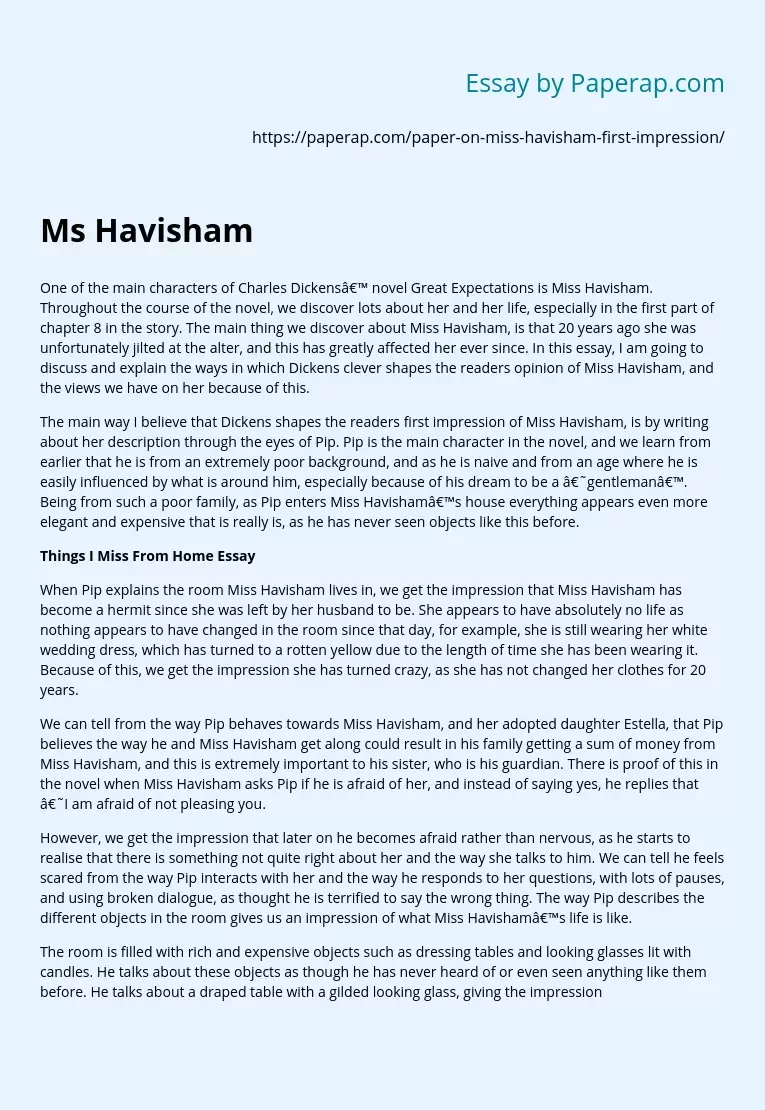Ms Havisham Character Analysis
One of the main characters of Charles Dickens’ novel Great Expectations is Miss Havisham. Throughout the course of the novel, we discover lots about her and her life, especially in the first part of chapter 8 in the story. The main thing we discover about Miss Havisham, is that 20 years ago she was unfortunately jilted at the alter, and this has greatly affected her ever since. In this essay, I am going to discuss and explain the ways in which Dickens clever shapes the readers opinion of Miss Havisham, and the views we have on her because of this.
The main way I believe that Dickens shapes the readers first impression of Miss Havisham, is by writing about her description through the eyes of Pip. Pip is the main character in the novel, and we learn from earlier that he is from an extremely poor background, and as he is naive and from an age where he is easily influenced by what is around him, especially because of his dream to be a ‘gentleman’.
Being from such a poor family, as Pip enters Miss Havisham’s house everything appears even more elegant and expensive that is really is, as he has never seen objects like this before.
Things I Miss From Home Essay
When Pip explains the room Miss Havisham lives in, we get the impression that Miss Havisham has become a hermit since she was left by her husband to be. She appears to have absolutely no life as nothing appears to have changed in the room since that day, for example, she is still wearing her white wedding dress, which has turned to a rotten yellow due to the length of time she has been wearing it.
Because of this, we get the impression she has turned crazy, as she has not changed her clothes for 20 years.
We can tell from the way Pip behaves towards Miss Havisham, and her adopted daughter Estella, that Pip believes the way he and Miss Havisham get along could result in his family getting a sum of money from Miss Havisham, and this is extremely important to his sister, who is his guardian. There is proof of this in the novel when Miss Havisham asks Pip if he is afraid of her, and instead of saying yes, he replies that ‘I am afraid of not pleasing you.
However, we get the impression that later on he becomes afraid rather than nervous, as he starts to realise that there is something not quite right about her and the way she talks to him. We can tell he feels scared from the way Pip interacts with her and the way he responds to her questions, with lots of pauses, and using broken dialogue, as thought he is terrified to say the wrong thing. The way Pip describes the different objects in the room gives us an impression of what Miss Havisham’s life is like.
The room is filled with rich and expensive objects such as dressing tables and looking glasses lit with candles. He talks about these objects as though he has never heard of or even seen anything like them before. He talks about a draped table with a gilded looking glass, giving the impression he thinks of these thing as elegant and special, and yet Miss Havisham appears to take little care of the things in the room. He describes what she is wearing as ‘rich materials – satins, lace, and silks – all of white’.
This gives us the impression she is glamorous and clean looking, whereas we later learn her ‘white’ clothes have turned yellow from not being washed in 20 years, as Pip says ‘I learn that everything in my view ought to be white, and was white long ago’. The room is filled with dirt and everything surrounding her is old and no longer elegant and rich looking as Pip first made out. We then get the impression Miss Havisham is unhealthy, unfed and unclean, from Pip’s description of how she looks.
We understand that she is ‘withered like her dress’, this use of simile shows that she has shrunk to skin and bone, and has bright, however sunken eyes. The author then compares Miss Havisham to a ghastly waxwork, and even worse a skeleton. Dickens then goes on to describe Pip’s fear by stating that ‘I should have cried out, if I could’. There is a strong contrast in the novel between white and yellow, it is often mentioned that everything surrounding Miss Havisham used to be white and fresh, but is dirty and yellow.
This appears to be comparing colours to Miss Havisham’s life, where she used to be young and youthful before she was jilted, but has now grown old and ill looking, The fact that Dickens has chosen to describe Miss Havisham’s surroundings prove to us how important it is to Dickens that we can understand Miss Havisham’s distress and depression. Dickens uses repetition throughout the novel to show the repetition in Miss Havisham’s life and how everything is always the same.
In conclusion, I believe that seeing as marriage was so important to women in the early 1900s due to the fact they felt as though they needed a man in their lives for financial and emotional security, this is the reason Miss Havisham is like this and Pip, being young and naive did not at all understand why she had turned so crazy and into a hermit, which is the reason Dickens chose to describe Miss Havisham through Pip’s eyes. Altogether, I believe the way that Dickens has written the novel gives us a view on the rich (Miss Havisham) and the poor (Pip) as he sees them. Money can turn you mad, and is definitely not everything.
Ms Havisham Character Analysis. (2019, Dec 05). Retrieved from https://paperap.com/paper-on-miss-havisham-first-impression/

